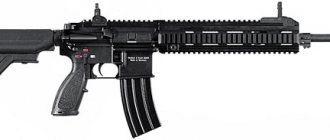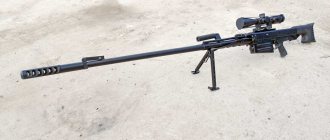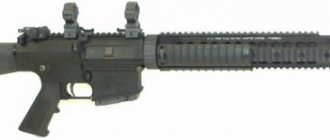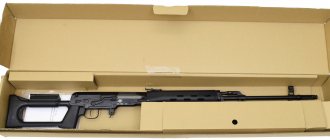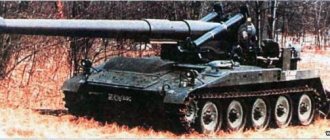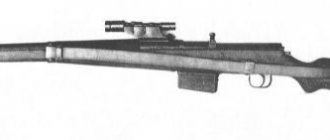Police "sniper" AMP DSR-1 from Germany
Two companies from Germany participated in the development of the police “sniper”:
- AMP Technical Services;
- DSR-Precision GmbH.
This is reflected in the name of this weapon. The sniper rifle was designated AMP DSR-1.
The weapon in question is a compact weapon aimed at police snipers
. It was created taking into account future use by counter-terrorism units. It was understood that most European special police departments would receive the AMP DSR-1.
The specificity of the purpose eliminated the need to create a rifle with the requirements for military models of such weapons:
- reliability;
- strength.
GSG 9 is staffed by volunteers from the German Federal Police. About 150 candidates are recruited annually. Those who successfully pass all tests are admitted to the training course, which lasts 22 weeks.
GSG 9 has 300 personnel in its ranks, which are divided into three operational detachments:
- GSG 9/1 - specializes in conducting anti-terrorist actions in standard conditions, 100 personnel,
- GSG 9/2 - anti-terrorist actions on ships and other maritime facilities, 100 personnel
- GSG 9/3 - a group of paratroopers, 50 personnel.
Each detachment is divided into operational groups of five people. These groups are not static - depending on the conditions, specialized groups of fighters can be formed, consisting of fighters with different skills and abilities necessary in a particular situation. In addition to operational groups, GSG 9 includes a headquarters group, a helicopter flight, a training detachment, a communications and information detachment, a group of technicians and a supply unit.
Users
- Denmark: Used by the Danish Navy - Danish Frogman Corps[3]
- Germany: Used by GSG 9 Counter-Terrorism Group.[1]
- Luxembourg: Used Unité Spéciale de la Police
of the Grand Ducal Police.[4][5] - Malaysia: Used by the Malaysian Armed Forces.[6][7]
- Mauritius: GIPM used.[ citation needed
] - Spain: Used Grupo Especial de Operaciones
(GEO)
Cuerpo Nacional de Policía
,
Grup Especial d'Intervenció
(GEI) Mossos d'Esquadra * Catalonia (Spain).[8] - Taiwan: Used by the Republic of China Army.[ citation needed
] - UAE: Used by the Union Defense Forces (UAE).[ citation needed
]
AMP DSR-1
Barrel length: 650 mm
Magazine capacity: 5-round box magazine (.308 Win. and .300 Win.Mag) 4-round box magazine (.338 Lapua Mag)
The AMP DSR-1 is a bolt-action sniper rifle developed in Germany in 2000 and still in production today.
The DSR-1 was developed as a specialized sniper rifle for use in police and counter-terrorism operations that require maximum accuracy and provide fairly simple operating conditions.
The DSR-1 is fired with 7.62 mm NATO (.308 Win), .300 Win Mag and .338 Lapua Mag rifle cartridges. When firing, cartridges are supplied from detachable box magazines with a capacity of 5 rounds. The magazine is single-row, the spare magazine is located in a special slot in front of the trigger guard.
The DSR-1 sniper rifle is built in a bullpup configuration. The barrel is cantilevered, with longitudinal valleys to reduce weight and improve cooling, and is equipped with a massive muzzle brake. The barrel is quick-change, fixed in the receiver with three screws.
The rotating bolt has six radial lugs in the front and is locked by turning directly behind the breech. The stock is fully adjustable, with an adjustable cheek pad, rear support and fore-end adjustable for longitudinal position.
Folding bipods are attached to special guides above the aluminum forend and provide the necessary movement of the rifle along all three axes.
The descent is adjustable, with advance warning. The rifle has a double-sided safety located above the trigger guard.
Currently, the AMP DSR-1 is in service with the police forces of many countries: Spain, Luxembourg, Germany, Malaysia and Taiwan. The AMP DSR-1 is in service with the elite German police special forces unit GSG 9, SEK M and KSK, as well as other European special forces and police agencies.
Options
V DSR-1 Subsonic
variant optimized for 7.62×51mm NATO/.308 Winchester using subsonic ammunition.
The barrel length is reduced to 310 mm. The 8" barrel twist rate is specifically tailored to stabilize the long, heavy projectiles used in subsonic ammunition. The propellant charge of subsonic ammunition is reduced to keep the bullet speed (300 m/s - 320 m/s) below the speed of sound (~340 m/s). At this subsonic speed, it avoids the supersonic cracking that occurs when firing standard ammunition. The manufacturer recommends using exclusively subsonic ammunition for the DSR-1 Subsonic. DSR-50.
The DSR-50 Sniper Rifle
This is a larger version of the DSR-1. It has a built-in hydraulic recoil damping system in the stock and a built-in muzzle brake. A forward-retracting muzzle brake, also described as a linear compensator, reduces perceived muzzle blast. The DSR-50 sniper rifle is chambered in .50 BMG (12.7×99mm NATO), significantly larger than the .338 Lapua Magnum cartridge, which is the largest available cartridge for the DSR-1 rifle. Sniper rifles chambered in .50 BMG are often used as anti-material rifles.
AMP DSR-1
Barrel length: 650 mm
Magazine capacity: 5-round box magazine (.308 Win. and .300 Win.Mag) 4-round box magazine (.338 Lapua Mag)
The AMP DSR-1 is a bolt-action sniper rifle developed in Germany in 2000 and still in production today.
The DSR-1 was developed as a specialized sniper rifle for use in police and counter-terrorism operations that require maximum accuracy and provide fairly simple operating conditions.
Design
The layout of the AMP DSR-1 is a so-called bullpup
, characterized by the following:
The magazine comes first, and only then the pistol grip.
A folding bipod mounted on the upper rails is mounted in front.
The back of the sniper rifle is adjustable. Here you have a folding stock with an offset of up to 50 mm, and a special support that can be extended by 170 mm. The latter provides the ability to be installed in the target positioning position.
The proposed photos clearly show that the AMP DSR-1 has, as it were, 2 installed magazines. This is wrong
. The working magazine is the one that comes first from the butt. The second is only secured in a special holder, which is done to speed up the reload time.
The fluted barrel is secured using 3 screws. Replacing it doesn't take much time. The barrel is complemented by a protective casing in the form of a ventilated aluminum structure. At the end there is a muzzle brake, which can be mounted to be suppressed in a few seconds. There is a special lever for this.
GSG 9 is staffed by volunteers from the German Federal Police. About 150 candidates are recruited annually. Those who successfully pass all tests are admitted to the training course, which lasts 22 weeks.
GSG 9 has 300 personnel in its ranks, which are divided into three operational detachments:
- GSG 9/1 - specializes in conducting anti-terrorist actions in standard conditions, 100 personnel,
- GSG 9/2 - anti-terrorist actions on ships and other maritime facilities, 100 personnel
- GSG 9/3 - a group of paratroopers, 50 personnel.
Each detachment is divided into operational groups of five people. These groups are not static - depending on the conditions, specialized groups of fighters can be formed, consisting of fighters with different skills and abilities necessary in a particular situation. In addition to operational groups, GSG 9 includes a headquarters group, a helicopter flight, a training detachment, a communications and information detachment, a group of technicians and a supply unit.
The DSR-1 system is a bullpup design with a free-floating barrel. The folding bipod is mounted on the upper rails (above the barrel), and the adjustable horizontal front handle is mounted on the lower rails (under the barrel). The rifle is equipped with a fully adjustable stock and cheekpiece. A spare magazine holder is installed in the front of the trigger guard to reduce reload time. The DSR-1 action features a tabletop, fluted barrel that is quickly replaced and secured to the receiver with three screws. The bolt has six lugs, which are fixed directly in the barrel. The barrel is protected by a ventilated aluminum forend and is equipped with a muzzle brake (which is very convenient when shooting at full power with Magnum cartridges). The trigger mechanism is two-stage, adjustable. The DSR-1 has a manual ambidextrous three-position safety located above the trigger guard. A tactical suppressor is available for the standard version of the DSR-1. The suppressor is designed for use with high power DSR-1 caliber ammunition. This suppressor effectively suppresses muzzle blast. Naturally, it cannot suppress the crack of a supersonic projectile, but the direction from which the bullet is flying is effectively hidden. The tactical suppressor is easily installed in seconds on the muzzle brake using a quick release lever.
Recommendations
- ^ a b c
"Modern firearms".
guns.ru.
_ - Bobwheeler.com (PDF). bobwheeler.com
. Archived from the original (PDF) on 2006-09-26. Retrieved 2008-02-29. - "Opening". Opening
. Archived from the original on March 30, 1997. - "Special police equipment - Sniper shooting." USP.lu
(In French). 2008. Archived from the original on 07/22/2011. Retrieved 2009-10-13. - "L'Unite d'Intervention de la Police L Luxembourggeoise" (PDF) (In French). RAIDS Magazine. March 2006. Archived from the original (PDF) on July 22, 2011. Retrieved 2009-09-23.
- Dan, Alex (9 February 2016). "PASCAL Weapons of Malaysian Special Forces." War Factory
(Small Hands). Archived from the original on February 14, 2016. Retrieved February 10, 2016. - "PASKAU Malaysian Special Air Service Weapons". Military plant. Archived from the original on May 7, 2016. Retrieved April 14, 2016.
- "Web Del Grupo Especial De Operaciones (GEO)". policia.es
(in Spanish). Archived from the original on 2011-05-20. Retrieved 2010-06-11.
